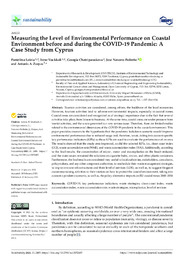Please use this identifier to cite or link to this item:
https://hdl.handle.net/11000/37969Full metadata record
| DC Field | Value | Language |
|---|---|---|
| dc.contributor.author | Loizia, Pantelitsa | - |
| dc.contributor.author | Voukkali, Irene | - |
| dc.contributor.author | Chatziparaskeva, Georgia | - |
| dc.contributor.author | Navarro-Pedreño, Jose | - |
| dc.contributor.author | Zorpas, Antonis A. | - |
| dc.contributor.other | Departamentos de la UMH::Agroquímica y Medio Ambiente | es_ES |
| dc.date.accessioned | 2025-11-07T11:12:03Z | - |
| dc.date.available | 2025-11-07T11:12:03Z | - |
| dc.date.created | 2021-02-25 | - |
| dc.identifier.citation | Sustainability 2021, 13(5), 2485; | es_ES |
| dc.identifier.issn | 2071-1050 | - |
| dc.identifier.uri | https://hdl.handle.net/11000/37969 | - |
| dc.description.abstract | Tourism activities are considered, among others, the backbone of the local economies. However, tourism activities lead to adverse environmental impacts, especially in coastal zones. Coastal areas are considered and recognized as of strategic importance due to the fact that several activities take place, from leisure to business. At the same time, coastal areas are under pressure from tourist activities, and the waste generated is a very serious issue. Therefore, there are limited studies related to the environmental dimensions of the COVID-19 pandemic in the coastal environment. This paper provides answers to the hypothesis that the pandemic lockdown scenario would improve environmental performance due to reduced usage and, therefore, waste, taking into account specific key performance indicators (KPIs) as these KPIs are used to evaluate the performance of an area. The results showed that the study area improved, as did the selected KPIs, i.e., clean coast index (CCI), waste accumulation rate (WAR), and waste accumulation index (WAI). Additionally, according to the final results, the concentration of micro-, meso- and macroplastics on the beach reduced, and the main issues remained the solutions on cigarette butts, straws, and other plastic containers. Furthermore, the final results are considered very useful to local authorities, stakeholders, consultants, policymakers, and any other competent authorities, to reschedule their waste management strategies, to improve waste infrastructures and their level of services (LOS), as well as, to suggest frequent awareness-raising activities to their visitors on how to protect the coastal environment, taking into account a pandemic scenario, as well as, the policy alternative impacts on EU coastal zones 2000–2050. | es_ES |
| dc.format | application/pdf | es_ES |
| dc.format.extent | 24 | es_ES |
| dc.language.iso | eng | es_ES |
| dc.publisher | MDPI | es_ES |
| dc.rights | info:eu-repo/semantics/openAccess | es_ES |
| dc.rights | Attribution-NonCommercial-NoDerivatives 4.0 Internacional | * |
| dc.rights.uri | http://creativecommons.org/licenses/by-nc-nd/4.0/ | * |
| dc.subject | COVID-19 | es_ES |
| dc.subject | key performance indicators | es_ES |
| dc.subject | waste strategies | es_ES |
| dc.subject | clean coast index | es_ES |
| dc.subject | waste accumulation index | es_ES |
| dc.subject | waste accumulation rate | es_ES |
| dc.subject | waste strategies | es_ES |
| dc.subject | microplastics | es_ES |
| dc.subject | level of services | es_ES |
| dc.subject.other | CDU::5 - Ciencias puras y naturales | es_ES |
| dc.title | Measuring the Level of Environmental Performance on Coastal Environment before and during the COVID-19 Pandemic: A Case Study from Cyprus | es_ES |
| dc.type | info:eu-repo/semantics/article | es_ES |
| dc.relation.publisherversion | https://doi.org/10.3390/su13052485 | es_ES |

View/Open:
33_sustainability-13-02485.pdf
7,89 MB
Adobe PDF
Share:
.png)
